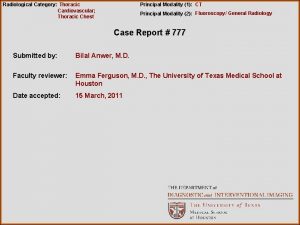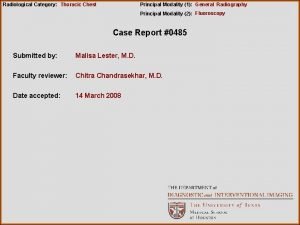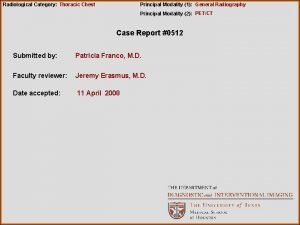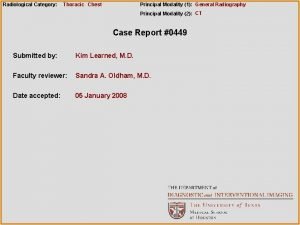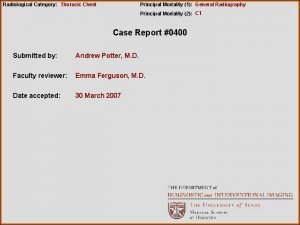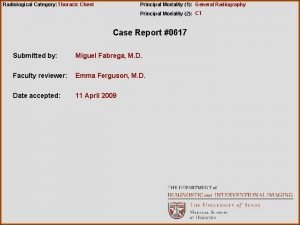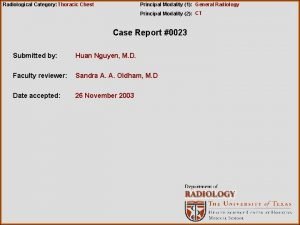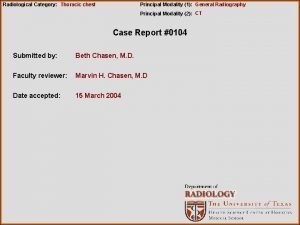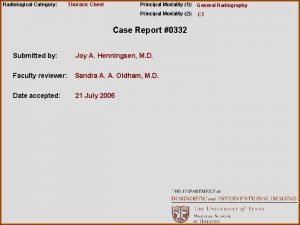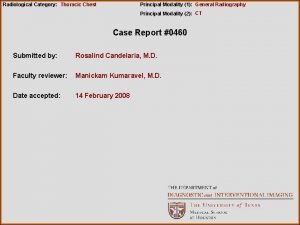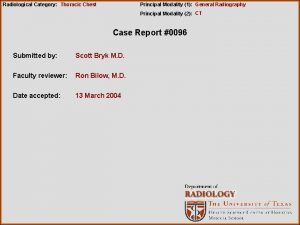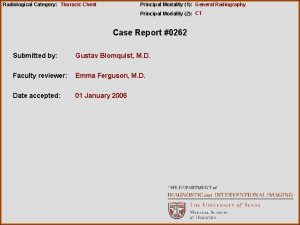Radiological Category Thoracic Chest Principal Modality 1 General














- Slides: 14

Radiological Category: Thoracic Chest Principal Modality (1): General Radiography Principal Modality (2): CT Case Report #0439 Submitted by: Justin Ord, M. D. Faculty reviewer: Emma Ferguson, M. D. Date accepted: 10 January 2008

Case History 40 year old female with shortness of breath.

Radiological Presentations

Test Your Diagnosis Which one of the following is your choice for the appropriate diagnosis? After your selection, go to next page. • Lymphoma • Extramedullary Hematopoiesis • Neurogenic Tumor • Mediastinal Lipomatosis • Other

Test Your Diagnosis There is a posterior mediastinal mass. The most common cause is a neurogenic tumor, such as a neurofibroma or schwannoma, but see if the following images change your choice.

Radiological Presentations

Radiological Presentations

Radiological Presentations

Test Your Diagnosis Now which one of the following is your choice for the appropriate diagnosis? After your selection, go to next page. • Lymphoma • Extramedullary Hematopoesis • Neurogenic Tumor • Mediastinal Lipomatosis • Other

Findings and Differentials Findings: CXR: There is a large, lobulated, posterior mediastinal mass. CT: There is a fat density posterior mediastinal mass, with areas of internal high density. Fat density masses are noted in the left lung and liver. Differentials: • Mediastinal Lipomatosis • Lipoma • Well differentiated Liposarcoma • High grade Liposarcoma

Discussion Liposarcoma is a malignancy of fat cells. In adults, it is the most common soft tissue sarcoma. Liposarcoma normally appears as a slowly enlarging, painless, mass in a middle-aged person. The mean patient age at onset is 50 years. Liposarcomas are most commonly found in the extremities; in the retroperitoneum; and, less often, in the head and neck area. These tumors are most likely to arise from deep-seated, well-vascularized structures than from submucosal or subcutaneous fat. The development of a liposarcoma from a preexisting benign lipoma is rare. Most cases arise de novo. Liposarcomas most frequently arise from the deep-seated stroma rather than the submucosal or subcutaneous fat. The most recent World Health Organization classification of soft tissue tumors recognizes 5 categories of liposarcomas: (1) well differentiated, which includes the adipocytic, sclerosing, and inflammatory subtypes; (2) dedifferentiated; (3) myxoid; (4) round cell; and (5) pleomorphic. Metastases are common, especially in poorly differentiated liposarcomas. The lungs and the liver are the most common sites of metastasis.

Discussion Most liposarcomas have well-defined and mostly lobulated margins. The welldifferentiated liposarcomas are composed of mainly fat with septa or nodules. These tumors demonstrate faint or no enhancement after the intravenous administration of contrast material. The malignancy grade increases with the degree of tumor heterogeneity and contrast enhancement. The tumor has internal nodularity and enhancement within the fat density, which is not consistent with mediastinal lipomatosis or a simple lipoms. The nodule in the lung, mediastinum, and masses in the liver are consistent with a high grade liposarcoma, as these have a higher propensity to metastasize. The patient in this case has a history of liposarcoma of the abdomen.

Diagnosis Liposarcoma

References Schwartz, Robert. Liposarcoma, Emedicine. com.
 E-rate category 1 vs category 2
E-rate category 1 vs category 2 National radiological emergency preparedness conference
National radiological emergency preparedness conference Radiological dispersal device
Radiological dispersal device Tennessee division of radiological health
Tennessee division of radiological health Center for devices and radiological health
Center for devices and radiological health Cardinality and modality
Cardinality and modality Tom arbuthnot
Tom arbuthnot Epistemic modality
Epistemic modality Birad 3
Birad 3 Modality statistics
Modality statistics Past tense in xhosa
Past tense in xhosa Modality in software engineering
Modality in software engineering Entity class in software engineering
Entity class in software engineering Deontic and epistemic modality exercises
Deontic and epistemic modality exercises Modality in software engineering
Modality in software engineering















